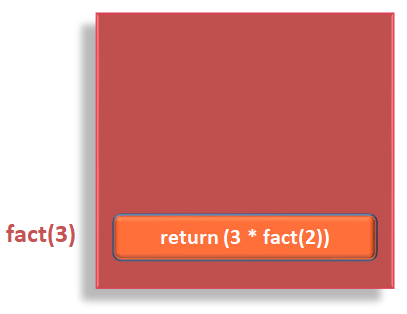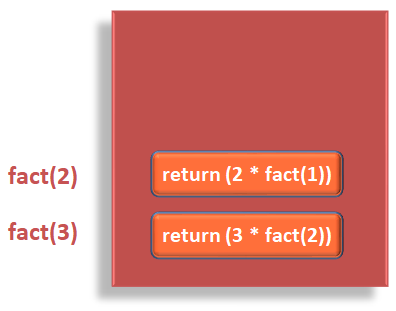

Recursion is a technique where a Function calls itself.
Let us understand Recursion using the program to find out the Factorial of a number.
Below is how we calculate the factorial of a number.
Say, we want to calculate the factorial of 3.
3 * 2 * 1 = 6
Similarly, the factorial of 6 is,
6 * 5 * 4 * 3 * 2 * 1 = 720
Below is a program to calculate the factorial of 3 using Recursion.
fun main() {
var n = 3
var f = fact(n)
println("The factorial of "+n+" is "+f)
}
fun fact(x: Int): Int {
if (x == 1) {
return 1
} else {
return (x * fact(x-1))
}
}
In the above code, we are calculating the factorial of 3.
So, we have initialised the value of n with 3.
var n = 3
And called the fact(n) Function, passing the value of n(i.e. 3).
var f = fact(n)
And the execution of fact() Function begins.
fun fact(x: Int): Int {
if (x == 1) {
return 1
} else {
return (x * fact(x-1))
}
}So, the value of x is 3(That is passed as argument).

Then in the next line, we have checked if the value of x is 1. If so, the method execution stops and 1 is returned.
if (x == 1) {
return 1
}Now, since the value of x is 3. We come to the else part and come across the recursive call, where the fact Function calls itself.
else {
return (x * fact(x-1))
}But the thing to note is that there is a return statement. A return statement actually means to return the value and finish the Function execution.
But in this case the value will not be returned immediately. Instead, the fact Function calls itself.
And Kotlin, maintains an internal Stack that is hidden from the user.
So, in the return statement, if we substitute the value of x with 3.
return (x * fact(x-1))
It becomes return (3 * fact(2)). And that is kept in the internal stack maintained by Kotlin.
For fact(3), Kotlin keeps a note in stack that the return value is return (3 * fact(2)).And the value of fact(2) is yet to be determined.

Now, fact(2) Function from return (3 * fact(2)) with the new Argument, 2 is called. And the first pass begins.
So, the value of x is 2(That is passed as recursive argument).

And the fact(2)(i.e. After substituting the value of x by 2) Function execution begins with new Argument 2.
fun fact(x: Int): Int {
if (x == 1) {
return 1
} else {
return (x * fact(x-1))
}
}Similarly, the control comes to the else statement and the return statement is encountered.
else {
return (x * fact(x-1))
}Even in this case Kotlin finds a recursive call to the fact Function.
So, it stores the value in the stack.
So, in the return statement, if we substitute the value of x with 3.
return (x * fact(x-1))
It is return (2 * fact(1)).

Now, fact(1) Function with the new Argument, 1 is called. And the second pass begins.
So, the value of x is 1(That is passed as recursive argument).

And the fact(1) Function execution begins with new Argument 1.
fun fact(x: Int): Int {
if (x == 1) {
return 1
} else {
return (x * fact(x-1))
}
}Now, the control comes to the if statement
if (x == 1) {
return 1
}and the return 1 statement is encountered.
Now, Kotlin doesn't find a recursive call to the fact Function.
And the return value for fact(1) is 1.

And now, it is time for Kotlin to Backtrack
i.e. To get the values out of the Stack.
So Kotlin goes to the top element of the stack and takes it out.

And the topmost element is fact(2) with value return (2 * fact(1)). So, it takes out fact(2) and substitutes the value of fact(1) with 1.
And the value of fact(2) becomes,
'fact(2)' --> 'return (2 * fact(1))' --> return (2*1) --> return 2
So, the value of fact(2) is 2.

So Kotlin goes to the stack again.

And the topmost element is fact(3) with value return (3 * fact(2)). So, it takes out fact(3) and substitutes the value of fact(2) with 2.
And the value of fact(3) becomes,
'fact(3)' --> 'return (3 * fact(2))' --> return (3*2) --> return 6
So, the value of fact(3) is 6.

Now since, the Stack is empty,

Kotlin returns the value of fact(3) i.e. 6.
And finally, the value is fact(3) is returned.
var f = fact(n)
And the returned value is assigned to f.

And the print statement,
println("The factorial of "+n+" is "+f)Prints the output.
The factorial of 3 is 6